Conservation History
Our Conservation History
In the last quarter-century, the Zoological Society of Milwaukee has made conservation a cornerstone of our mission. From supporting Milwaukee County Zoo and other regional conservation research projects to operating three signature programs of our own – the Bonobo & Congo Biodiversity Initiative, Wildlife Conservation Grants for Graduate Student Research, and Birds Without Borders Aves Sin Fronteras – the Zoological Society has been on a mission to empower conservationists to save species and our environment.
Local and Regional Support
Over the years, the Zoological Society supported original ecological research on many species endemic to Wisconsin including the timber rattlesnake, trumpeter swan, eastern massasauga rattlesnake, little brown bat, ornate box turtle, and lake trout. The Zoological Society also helped support the reintroduction of elk to the state. Ecological research for wildlife support focused on the creation of baseline population data for the species, habitat and range assessment, and additional surveys to monitor biodiversity and species abundance.
Local and Regional Support
Over the years, the Zoological Society supported original ecological research on many species endemic to Wisconsin including the timber rattlesnake, trumpeter swan, eastern massasauga rattlesnake, little brown bat, ornate box turtle, and lake trout. The Zoological Society also helped support the reintroduction of elk to the state. Ecological research for wildlife support focused on the creation of baseline population data for the species, habitat and range assessment, and additional surveys to monitor biodiversity and species abundance.
Zoological Society of Milwaukee
Past Signature Programs
Learn more about the signature programs from the Zoological Society’s past, how they supported conservation both locally and globally, and what significant conservation objectives were accomplished during their tenure.
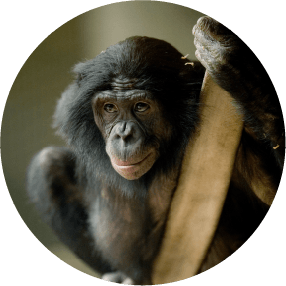
Bonobo & Congo Biodiversity Initiative
The Zoological Society operated the Bonobo & Congo Biodiversity Initiative (BCBI) for 20 years under Dr. Gay Edwards Reinartz. For more than 20 years, under Dr. Reinartz’s direction, BCBI studied and helped ensure the survival of the endangered bonobo and forest elephant and helped maintain the biodiversity of Salonga National Park in the Democratic Republic of Congo. BCBI also supported five primary schools in local villages with teacher salaries and supplies, as well as adult literacy classes and training in sustainable agriculture. We are proud of this work and our contributions to the global conservation community, which include:
- Developed a proven model for protecting the Salonga National Park’s extensive biodiversity
- Discovered possibly the largest, continuous bonobo population thus far described for the species (+4,000 bonobos)
- Confirmed the Salonga National Park as the world’s premier site for bonobo conservation
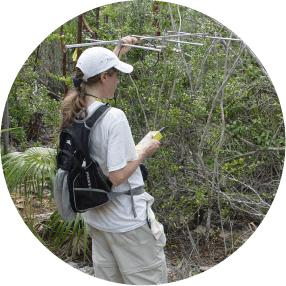
Wildlife Conservation Grants for Graduate Student Research
The Wildlife Conservation Grants for Graduate Student Research operated over a 14-year period and funded 170 proposals totaling over $270,000. Students conducted their studies globally and covered a vast array of species and conservation problems. Student projects were selected based on their direct application to an urgent conservation problem, feasibility, and academic merit. An advisory committee composed of academic specialists reviewed proposals annually and made recommendations for funding.
- Over 150 graduate students supported
- Research conducted on 4 continents, 24 countries
- Over 60% of supported students hold leadership positions in conservation today
- Some examples of supported student research over the years:
- GPS mapping of lemur forest habitats in Madagascar’s Spiny Desert
- Conservation implications for forest songbirds in Northern Wisconsin forests
- Field surveys of Hylobates lar (gibbons) in Central Laos
- Effects of habitat fragmentation and landscape patterns on forest bird conservation in Chile
- Methods for restoring Tamarack (Laix laricina) to wetlands in Southeastern Wisconsin
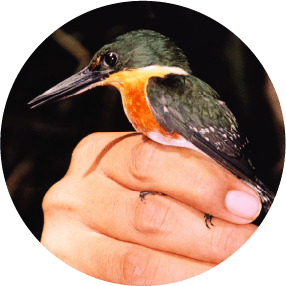
Birds Without Borders – Aves Sin Fronteras®
Birds Without Borders-Aves Sin Fronteras® was a research, conservation, and education project started in 1996 to study migratory and resident bird species in Wisconsin and the Central American country of Belize. The project resulted in two manuals created to help landowners in the U.S. and Belize learn how to protect and provide habitat for birds that migrate annually between the two countries.
Results of the project included:
-
- More than 14,600 birds were banded at study sites in Belize and Wisconsin
- More than 500 nests were monitored at Wisconsin study sites
- Eight scientific papers were published in peer-reviewed journals
- More than 1,800 printed copies of the Landowner Recommendation manuals were distributed via outreach talks in communities near the study sites in Belize and Wisconsin
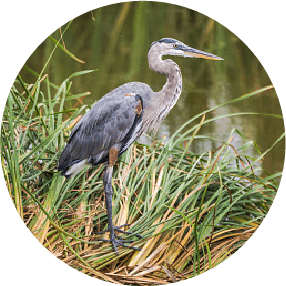
Nesting Platforms
In 1991 the Zoological Society of Milwaukee joined the U.S. Department of the Interior Fish and Wildlife Service and the DNR to help the egret, black-crowned night heron and great blue heron population in the Horicon Marsh. The trees these birds nest in were dying from the effects of heron guano and Dutch elm disease. The group created nesting platforms and dropped them from a helicopter into the marsh.
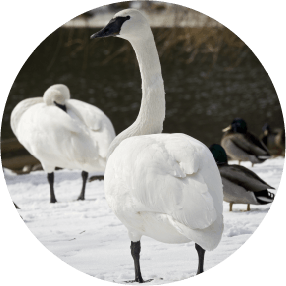
Trumpeter Swan Restoration Program
The Zoological Society helped fund and support the revival of trumpeter swans in Wisconsin. Prior to 1987, it had been one hundred years since a pair of trumpeters reproduced in Wisconsin. To restore breeding Wisconsin DNR flew to Alaska to collect trumpeter swan eggs and brought them to the Milwaukee County Zoo to be hatched and prepared for wild release. This highly successful program created dozens of nesting pairs in the state of Wisconsin.

